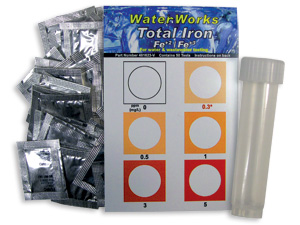We have had many people ask us about potential problems and/or dangers associated with the presence of iron in drinking water since we started the Water Testing Blog. We attribute the public’s interest in iron in drinking water to its ability to stain fixtures, clog certain types of filters, stain clothes, ruin the taste of food and beverages, cause water to have an unpleasant taste, etc.
Despite all those drawbacks to the presence of iron in drinking water, it does not, at least according to the current Primary and Secondary Drinking Water Standards set forth by the USEPA, pose much of a health risk.
Note: The USEPA has set the Maximum Contaminant Level for iron in drinking water at 0.3 ppm in their Secondary Drinking Water Standards, which deal more with aesthetic properties of water than with health-related issues.
Most often when testing for iron people will test for Ferrous Iron:
* Ferrous — This form of iron results in the most complaints and reasons for examination of water for iron content. If allowed to remain in a state with little oxygen present, this type of iron remains in solution and the water will appear colorless. However, in the case of tap water allowed to remain in service lines coming from a well or other source, rust colored iron particles may begin to precipitate out of solution. These particles obviously ruin water clarity and give the impression of unsafe drinking water. Additionally, they clog certain types of water filtration systems and cause the owners of those water filtration systems to replace them well in advance of their expected replacement dates. Water professionals often refer to this type of iron in water as ‘clear iron’. ( source )
To test for the presence of iron in water yourself, you can choose from several different methods:
- Liquid, Tablet and/or Powder Test Kits — see Taylor Iron K-1716 Test Kit
- Electronic Meters — see eXact Micro 7+ and Color Q PRO 11
- Test Strips — see Ida’s Iron, Iron Check, AquaChek Iron, and Visual Total Iron





